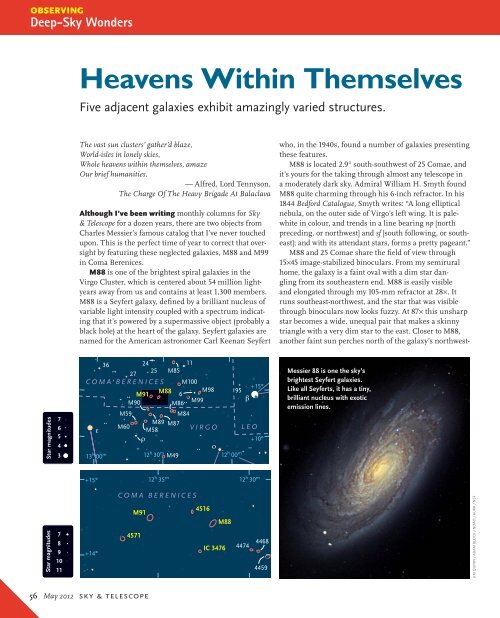Download this ebook as PDF - E-Book Library
Download this ebook as PDF - E-Book Library
Download this ebook as PDF - E-Book Library
You also want an ePaper? Increase the reach of your titles
YUMPU automatically turns print PDFs into web optimized ePapers that Google loves.
OBSERVING<br />
Deep-Sky Wonders<br />
Star magnitudes<br />
Star magnitudes<br />
7<br />
6<br />
5<br />
4<br />
3<br />
7<br />
8<br />
9<br />
10<br />
11<br />
Heavens Within Themselves<br />
Five adjacent galaxies exhibit amazingly varied structures.<br />
The v<strong>as</strong>t sun clusters’ gather’d blaze,<br />
World-isles in lonely skies,<br />
Whole heavens within themselves, amaze<br />
Our brief humanities.<br />
— Alfred, Lord Tennyson,<br />
The Charge Of The Heavy Brigade At Balaclava<br />
Although I’ve been writing monthly columns for Sky<br />
& Telescope for a dozen years, there are two objects from<br />
Charles Messier’s famous catalog that I’ve never touched<br />
upon. This is the perfect time of year to correct that oversight<br />
by featuring these neglected galaxies, M88 and M99<br />
in Coma Berenices.<br />
M88 is one of the brightest spiral galaxies in the<br />
Virgo Cluster, which is centered about 54 million lightyears<br />
away from us and contains at le<strong>as</strong>t 1,300 members.<br />
M88 is a Seyfert galaxy, defi ned by a brilliant nucleus of<br />
variable light intensity coupled with a spectrum indicating<br />
that it’s powered by a superm<strong>as</strong>sive object (probably a<br />
black hole) at the heart of the galaxy. Seyfert galaxies are<br />
named for the American <strong>as</strong>tronomer Carl Keenan Seyfert<br />
36<br />
27<br />
24<br />
25 M85<br />
11<br />
COMA BERENICES M100<br />
M88 M98<br />
M91 6<br />
M90 M86<br />
M99<br />
95<br />
<br />
M59<br />
M84<br />
<br />
M60<br />
M89 M87<br />
M58 VIRGO LEO<br />
<br />
<br />
12 M49<br />
h 30m 13h 00m +15°<br />
+10°<br />
12h 00m +15°<br />
+14°<br />
M91<br />
4571<br />
56 May 2012 sky & telescope<br />
12 h 35 m<br />
COMA BERENICES<br />
4516<br />
M88<br />
IC 3476<br />
12 h 30 m<br />
4474<br />
4468<br />
4459<br />
who, in the 1940s, found a number of galaxies presenting<br />
these features.<br />
M88 is located 2.9° south-southwest of 25 Comae, and<br />
it’s yours for the taking through almost any telescope in<br />
a moderately dark sky. Admiral William H. Smyth found<br />
M88 quite charming through his 6-inch refractor. In his<br />
1844 Bedford Catalogue, Smyth writes: “A long elliptical<br />
nebula, on the outer side of Virgo’s left wing. It is palewhite<br />
in colour, and trends in a line bearing np [north<br />
preceding, or northwest] and sf [south following, or southe<strong>as</strong>t];<br />
and with its attendant stars, forms a pretty pageant.”<br />
M88 and 25 Comae share the fi eld of view through<br />
15×45 image-stabilized binoculars. From my semirural<br />
home, the galaxy is a faint oval with a dim star dangling<br />
from its southe<strong>as</strong>tern end. M88 is e<strong>as</strong>ily visible<br />
and elongated through my 105-mm refractor at 28×. It<br />
runs southe<strong>as</strong>t-northwest, and the star that w<strong>as</strong> visible<br />
through binoculars now looks fuzzy. At 87× <strong>this</strong> unsharp<br />
star becomes a wide, unequal pair that makes a skinny<br />
triangle with a very dim star to the e<strong>as</strong>t. Closer to M88,<br />
another faint sun perches north of the galaxy’s northwest-<br />
Messier 88 is one the sky’s<br />
brightest Seyfert galaxies.<br />
Like all Seyferts, it h<strong>as</strong> a tiny,<br />
brilliant nucleus with exotic<br />
emission lines.<br />
JIM QUINN / ADAM BLOCK / NOAO / AURA / NSF


